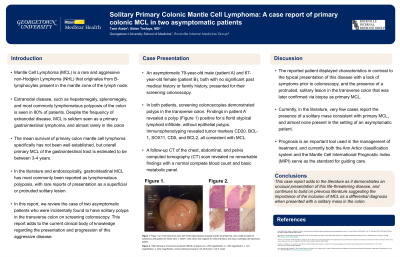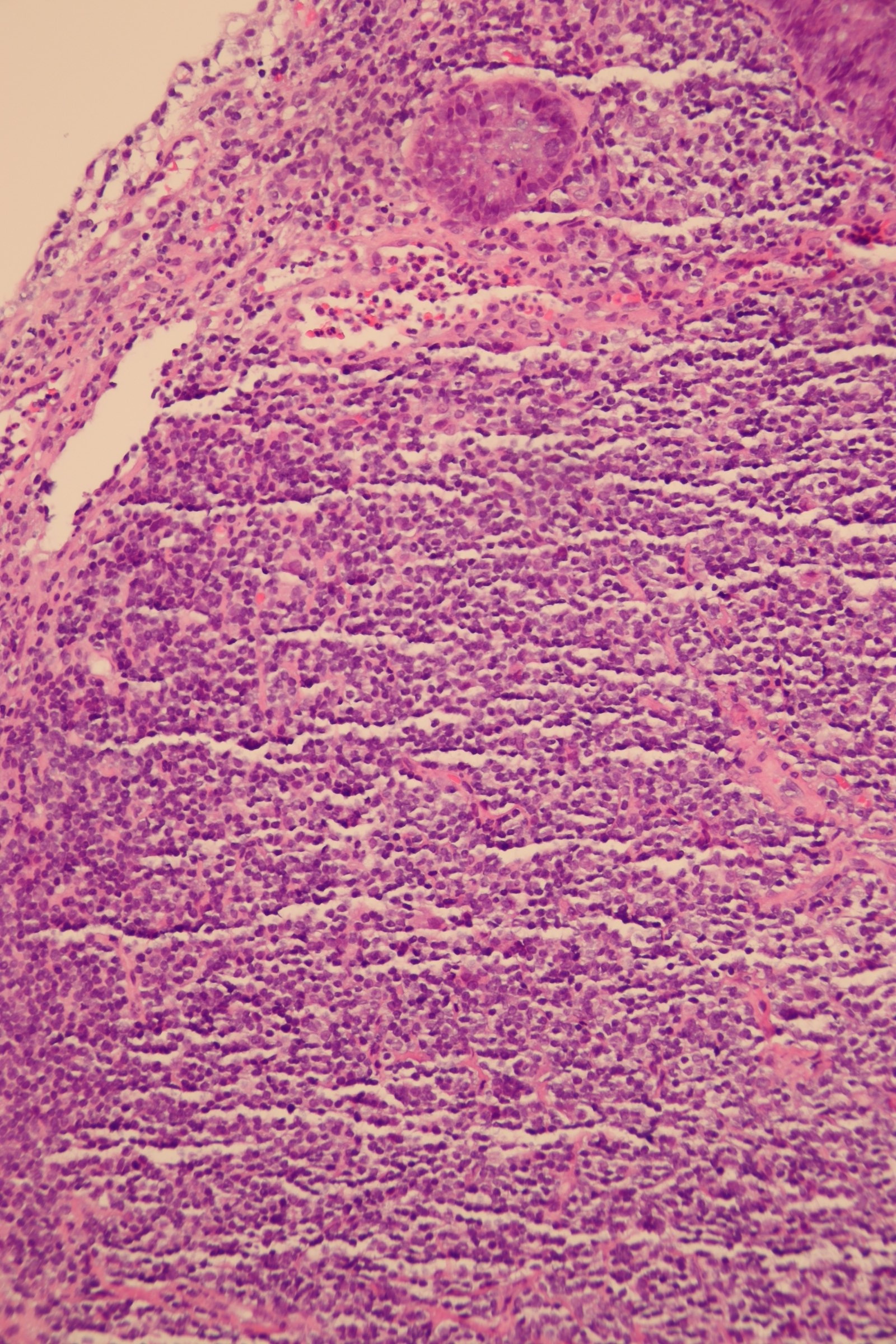Sunday Poster Session
Category: Colon
P0323 - Solitary Primary Colonic Mantle Cell Lymphoma: A Case Report of Primary Colonic Mantle Cell Lymphoma in Two Asymptomatic Patients
Sunday, October 22, 2023
3:30 PM - 7:00 PM PT
Location: Exhibit Hall

Has Audio

Tami Alade, BA
Georgetown University School of Medicine
Washington, District of Columbia
Presenting Author(s)
Tami Alade, BA1, Belen Tesfaye, MD2
1Georgetown University School of Medicine, Washington, DC; 2Rockville Internal Medicine Group, Rockville, MD
Introduction: Mantle Cell Lymphoma (MCL) is a rare and aggressive non-Hodgkin Lymphoma (NHL) that originates from B-lymphocytes present in the mantle zone of the lymph node. While extranodal disease is common in MCL (ex. hepatomegaly, splenomegaly, and lymphomatosis polyposis), it is seldom seen as a primary gastrointestinal lymphoma, and almost rarely in the colon. Overall, survival of primary MCL of the gastrointestinal tract is estimated to be between 3-4 years. In this report, we review the cases of two asymptomatic patients who were incidentally found to have solitary polyps in the transverse colon on screening colonoscopy.
Case Description/Methods: An asymptomatic 79-year-old male and 67-year-old female, both with no significant past medical history or family history, presented for their screening colonoscopy. In both patients, screening colonoscopies demonstrated polyps in the transverse colon. Findings were positive for a florid atypical lymphoid infiltrate, without epithelial polyps. Immunophenotyping revealed tumor markers CD20, BCL-1, SOX11, CD5, and BCL2, all consistent with MCL. A follow-up CT of the chest, abdominal, and pelvis computed tomography (CT) scan in both patients revealed no remarkable findings with a normal complete blood count and basic metabolic panel.
Discussion: Primary MCL of the colon occurs rarely, and most typically presents as multiple lymphomatous polyposis with symptoms such as abdominal pain, weight loss, and a palpable abdominal mass demonstrated on physical examination. The reported patients display characteristics in contrast to the typical presentation of this disease with a lack of symptoms prior to colonoscopy, and the presence of a protruded, solitary lesion in the transverse colon that was later confirmed via biopsy as primary MCL. Currently, in the literature, very few cases report the presence of a solitary mass consistent with primary MCL, and almost none are present in the setting of an asymptomatic patient. This report adds to the current clinical body of knowledge regarding the presentation and progression of this aggressive disease.

Disclosures:
Tami Alade, BA1, Belen Tesfaye, MD2. P0323 - Solitary Primary Colonic Mantle Cell Lymphoma: A Case Report of Primary Colonic Mantle Cell Lymphoma in Two Asymptomatic Patients, ACG 2023 Annual Scientific Meeting Abstracts. Vancouver, BC, Canada: American College of Gastroenterology.
1Georgetown University School of Medicine, Washington, DC; 2Rockville Internal Medicine Group, Rockville, MD
Introduction: Mantle Cell Lymphoma (MCL) is a rare and aggressive non-Hodgkin Lymphoma (NHL) that originates from B-lymphocytes present in the mantle zone of the lymph node. While extranodal disease is common in MCL (ex. hepatomegaly, splenomegaly, and lymphomatosis polyposis), it is seldom seen as a primary gastrointestinal lymphoma, and almost rarely in the colon. Overall, survival of primary MCL of the gastrointestinal tract is estimated to be between 3-4 years. In this report, we review the cases of two asymptomatic patients who were incidentally found to have solitary polyps in the transverse colon on screening colonoscopy.
Case Description/Methods: An asymptomatic 79-year-old male and 67-year-old female, both with no significant past medical history or family history, presented for their screening colonoscopy. In both patients, screening colonoscopies demonstrated polyps in the transverse colon. Findings were positive for a florid atypical lymphoid infiltrate, without epithelial polyps. Immunophenotyping revealed tumor markers CD20, BCL-1, SOX11, CD5, and BCL2, all consistent with MCL. A follow-up CT of the chest, abdominal, and pelvis computed tomography (CT) scan in both patients revealed no remarkable findings with a normal complete blood count and basic metabolic panel.
Discussion: Primary MCL of the colon occurs rarely, and most typically presents as multiple lymphomatous polyposis with symptoms such as abdominal pain, weight loss, and a palpable abdominal mass demonstrated on physical examination. The reported patients display characteristics in contrast to the typical presentation of this disease with a lack of symptoms prior to colonoscopy, and the presence of a protruded, solitary lesion in the transverse colon that was later confirmed via biopsy as primary MCL. Currently, in the literature, very few cases report the presence of a solitary mass consistent with primary MCL, and almost none are present in the setting of an asymptomatic patient. This report adds to the current clinical body of knowledge regarding the presentation and progression of this aggressive disease.

Figure: H&E staining of lymphoid infiltrate on biopsy (x200)
Disclosures:
Tami Alade indicated no relevant financial relationships.
Belen Tesfaye indicated no relevant financial relationships.
Tami Alade, BA1, Belen Tesfaye, MD2. P0323 - Solitary Primary Colonic Mantle Cell Lymphoma: A Case Report of Primary Colonic Mantle Cell Lymphoma in Two Asymptomatic Patients, ACG 2023 Annual Scientific Meeting Abstracts. Vancouver, BC, Canada: American College of Gastroenterology.
